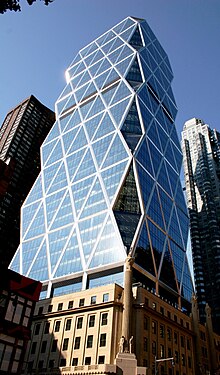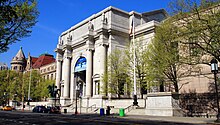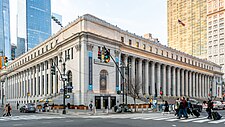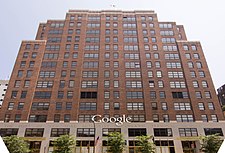Eighth Avenue (Manhattan)
| Central Park West (59th– St. Nicholas Avenue (above 124th Street) | |
| Construction | |
|---|---|
| Commissioned | March 1811 |
Eighth Avenue is a major north–south avenue on the west side of Manhattan in New York City, carrying northbound traffic below 59th Street. It is one of the original avenues of the Commissioners' Plan of 1811 to run the length of Manhattan, though today the name changes twice: At 59th Street/Columbus Circle, it becomes Central Park West, where it forms the western boundary of Central Park, and north of 110th Street/Frederick Douglass Circle, it is known as Frederick Douglass Boulevard before merging onto Harlem River Drive north of 155th Street.
Description

Eighth Avenue begins in the
The New York City Subway's IND Eighth Avenue Line, serving the A, C, and E trains in Lower Manhattan and the A, B, C, and D trains in the Upper West Side, runs under Eighth Avenue.[2][3]
Southernmost section
The southernmost section is known solely as Eighth Avenue between Abingdon Square and Columbus Circle. This portion of Eighth Avenue has carried traffic one-way northbound since June 6, 1954.[5]
Since the 1990s, the stretch of Eighth Avenue that runs through
Central Park West

North of Columbus Circle, the roadway becomes Central Park West (abbreviated to CPW). Unlike many Manhattan avenues, CPW has traffic running in two directions, and its address numbering system is different from that of the rest of Eighth Avenue. As its name indicates, CPW forms the western edge of
Several notable residences on Central Park West include:
- The Dakota, where John Lennon lived with current resident Yoko Ono,[6] and outside of which he was murdered in 1980[7]
- The San Remo, home to Demi Moore, Diane Keaton, Steve Martin, and U2's Bono
- The El Dorado
- The Beresford, home to Jerry Seinfeld[8] and Diana Ross[8]
- The Langham
- The Century
- 15 Central Park West, home to Sting,[9] Alex Rodriguez[9] and Ekaterina Rybolovleva[10]
- Madonna
- 455 Central Park West
- The St. Urban
- The Majestic, home to some of the former heads of the Genovese crime family, including Meyer Lansky, Lucky Luciano and Frank Costello. In 1957, Vincent "The Chin" Gigante shot Frank Costello in the lobby of The Majestic in a failed assassination attempt[11][12]
According to
Most of these housing cooperatives were built around 1930, replacing late-19th century hotels with the same names. Some, including The Century, The San Remo, The Majestic, and The El Dorado, are twin towers. Other landmarks and institutions along its length include the New-York Historical Society and the American Museum of Natural History. The area from 61st to 97th Streets is included in the Central Park West Historic District.[14]
The building located at 55 Central Park West is the infamous "Spook Central" from the movie Ghostbusters.[15][16] The famed New York City restaurant Tavern on the Green is located off Central Park West, at 66th Street, within the grounds of Central Park.[17][18]
In 1899, while exiting a streetcar,
Frederick Douglass Boulevard
North of Frederick Douglass Circle at 110th Street in Harlem, it is Frederick Douglass Boulevard, though sometimes still unofficially referred to as Eighth Avenue. Frederick Douglass Boulevard eventually terminates near the Harlem River at the Harlem River Drive around West 159th Street. While Central Park West has its own address system, address numbers on Frederick Douglass Boulevard continue as if Central Park West had used Eighth Avenue's numbering system.
The corridor along Frederick Douglass Boulevard was
A 2007–2011 census survey estimated that 61 percent of the 57,897 people living along and around Eighth were black, down from 74 percent in 2000. The share of whites jumped to 12.4 percent from 2.3 percent. Median household income rose 28 percent, to $34,694.[20]
Points of interest
- The Fashion Institute of Technology (at 26th/27th Streets)
- Penn Station(between 31st and 33rd Streets)
- James Farley Post Office
- The New York Times Building at 40th Street
- The Port Authority Bus Terminal (between 40th and 42nd Streets)
- One Worldwide Plaza
- Hearst Tower
- Open Society Instituteheadquarters on West 59th Street
- 111 Eighth Avenue, the Art Deco former Inland Freight Terminal of the Port Authority, is the eighth-largest commercial structure in Manhattan,[23] hosting the East Coast headquarters of Google.
Gallery
-
The north building of the Port Authority Bus Terminal at West 42nd Street
-
ThePenn Station
-
The original New York Cancer Hospital,[24] built between 1884 and 1886, now housing, at 455 Central Park West and 106th Street
-
The former Inland Freight Terminal at 111 Eighth Avenue, now home to Google
-
Police station at 148th Street
References
Notes
- ^ Google (September 13, 2015). "Eighth Avenue / Central Park West / Frederick Douglass Boulevard" (Map). Google Maps. Google. Retrieved September 13, 2015.
- OCLC 49777633.
- ^ "Subway Map" (PDF). Metropolitan Transportation Authority. September 2021. Retrieved September 17, 2021.
- ^ "Manhattan Bus Map" (PDF). Metropolitan Transportation Authority. July 2019. Retrieved December 1, 2020.
- ^ Ingraham, Joseph (June 7, 1954). "7th and 8th Aves. Shift to One-Way". The New York Times. Retrieved August 28, 2012.
- Daily News(New York).
- ^ "Lennon's murder". jfkmontreal.com. Archived October 19, 2013, at the Wayback Machine
- ^ a b Clarke, Katherine, "Beresford Wants Hot Dog Vendor Off Its Corner", TheRealDeal.com, August 30, 2012
- ^ a b Moritz, Owen (February 28, 2010). "A-Rod joins Sting, Denzel Washington, other rich and famous at 15 Central Park West, Owen Moritz" Archived 2010-03-02 at the Wayback Machine. Daily News (New York).
- ^ Na Zdarovia Dmitry Rybolovlev! Fertilizer Kingpin Buys Sandy Weill's $88 M. Penthouse, The New York Observer, December 18, 2011.
- ^ Gray, Christopher (August 12, 2007). "Where the Name Says It All". The New York Times. Retrieved September 8, 2011.
- ^ Burrough, Bryan. Public Enemies: America's Greatest Crime Wave and the Birth of the FBI, 1933–34.
- ISBN 9780300144307.
- ^ "National Register Information System". National Register of Historic Places. National Park Service. July 9, 2010.
- ^ Gaines, Steven. "One Apartment, 75 Years," New York Magazine, November 7, 2005. Retrieved April 3, 2007.
- ^ Aykroyd, Dan and Ramis, Harold. Reitman, Ivan, Director. Ghostbusters (Film). New York City: Columbia Pictures., June 8, 1984.
- ^ Tavern on the Green profile and articles at The New York Times
- ^ "Tavern on the Green". Archived from the original on May 14, 2014. Retrieved May 14, 2014.
- ^ Fatally hurt by automobile, The New York Times article, September 14, 1899.
- ^ a b Gill, John F. (December 31, 2013). "Frederick Douglass Boulevard: Newly Revived". The New York Times. Retrieved October 24, 2014.
- ^ Gregory, Kia (December 3, 2012). "A Boulevard in Harlem Undergoes a Resurgence". The New York Times. Retrieved October 24, 2014.
- ^ Kaminer, Michael (January 5, 2014). "Harlem's Frederick Douglass Blvd. is home to a restaurant renaissance". New York Daily News. Retrieved October 24, 2014.
- ^ "Commercial Real Estate; Behemoth of a Building Is Set for a Tenant Influx". The New York Times. November 19, 1997.
- ^ Barbanel, Josh. "Would an Aardvark Live Here?" The New York Times, September 17, 2006. Accessed December 31, 2009.
External links
- New York Songlines: Eighth Avenue, a virtual walking tour



![The original New York Cancer Hospital,[24] built between 1884 and 1886, now housing, at 455 Central Park West and 106th Street](http://upload.wikimedia.org/wikipedia/commons/thumb/1/15/Nycanchospjeh.JPG/225px-Nycanchospjeh.JPG)

